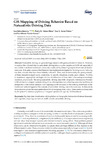GIS mapping of driving behavior based on naturalistic driving data

Ver/
Use este enlace para citar
http://hdl.handle.net/2183/23331Coleccións
Metadatos
Mostrar o rexistro completo do ítemTítulo
GIS mapping of driving behavior based on naturalistic driving dataAutor(es)
Data
2019Cita bibliográfica
Balsa-Barreiro, J.; Valero-Mora, P.M.; Berné-Valero, J.L.; Varela-García, F.-A. GIS mapping of driving behavior based on naturalistic driving data. ISPRS Int. J. Geo-Inf. 2019, 8, 226.
Resumo
[Abstract:] Naturalistic driving can generate huge datasets with great potential for research. However, to analyze the collected data in naturalistic driving trials is quite complex and difficult, especially if we consider that these studies are commonly conducted by research groups with somewhat limited resources. It is quite common that these studies implement strategies for thinning and/or reducing the data volumes that have been initially collected. Thus, and unfortunately, the great potential of these datasets is significantly constrained to specific situations, events, and contexts. For this, to implement appropriate strategies for the visualization of these data is becoming increasingly necessary, at any scale. Mapping naturalistic driving data with Geographic Information Systems (GIS) allows for a deeper understanding of our driving behavior, achieving a smarter and broader perspective of the whole datasets. GIS mapping allows for many of the existing drawbacks of the traditional methodologies for the analysis of naturalistic driving data to be overcome. In this article, we analyze which are the main assets related to GIS mapping of such data. These assets are dominated by the powerful interface graphics and the great operational capacity of GIS software.
Palabras chave
Big Data
Data visualization
Driving behavior
Geographic information systems
Kinematic (driving) data
Mapping
Microscopic traffic model
Naturalistic driving
Data visualization
Driving behavior
Geographic information systems
Kinematic (driving) data
Mapping
Microscopic traffic model
Naturalistic driving
Descrición
Este artigo pertence ao número especial Smart Cartography for Big Data Solutions.
Versión do editor
Dereitos
Atribución 3.0 España
Ítems relacionados
Mostrando ítems relacionados por Título, autor ou materia.
-
Maniobra cooperativa Stop & Go para vehículos automatizados basada en entorno virtual y real
Hidalgo, Carlos; Marcano, Mauricio; Fernández, Gerardo; Pérez, Joshué (Área de Ingeniería de Sistemas y Automática, Universidad de Extremadura, 2018)[Resumen] La implementación de maniobras cooperativas entre vehículos automatizados es una necesidad dentro del progreso de los Sistemas Avanzado de Asistencia al Conductor (ADAS). Sin embargo, el desarrollo de estas ... -
Framework for motion prediction of vehicles in a simulation environment
Medina Lee, Juan Felipe; Trentin, Vinicius; Villagra, Jorge (Universidade da Coruña, Servizo de Publicacións, 2019)[Abstract] Efficient testing and validation of software components for highly automate vehicles is one of the key challenges to be solved for their massive deployment. The number of driving situation and environment variables ... -
Caracterización de los sistemas de actuación para vehículos altamente automatizados
Sarabia, Joseba; Matute-Peaspan, Jose A.; Zubizarreta, Asier (Universidade da Coruña, Servizo de Publicacións, 2019)[Resumen] Los modelos de simulación son importantes para la investigación y desarrollo de estrategias de decisión y control en vehículos automatizados. Las plataformas de pruebas reales se obtienen generalmente mediante ...






